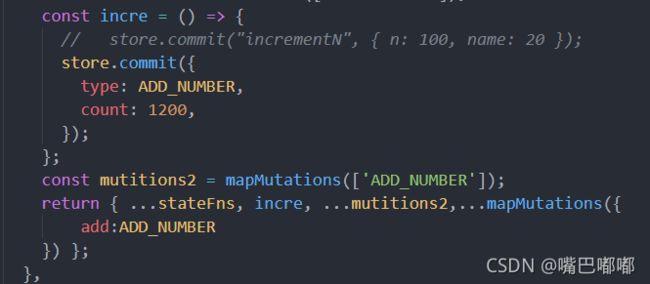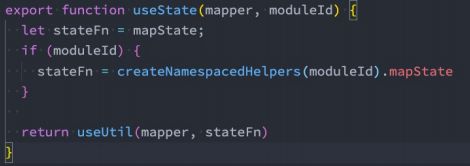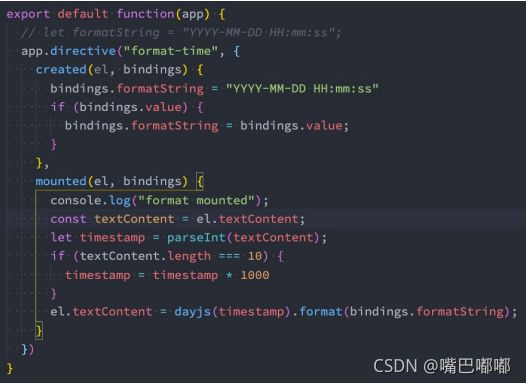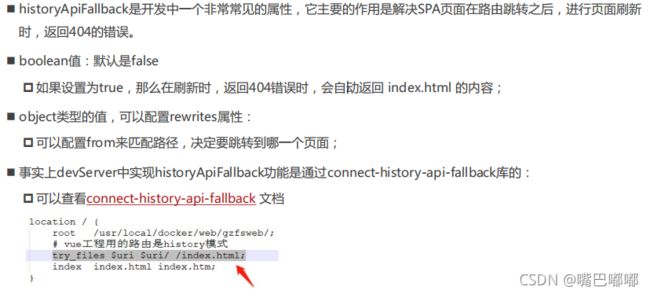vue3中vuex教程
什么是状态管理
在开发中,我们会的应用程序需要处理各种各样的数据,这些
数据需要保存在我们应用程序中的某一个位置,对于这些数据
的管理我们就称之为是 状态管理。
- 在Vue开发中,我们使用组件化的开发方式;
- 而在组件中我们定义data或者在setup中返回使用的数据,
这些数据我们称之为state; - 在模块template中我们可以使用这些数据,模块最终会被渲染成DOM,我们称之为View;
- 在模块中我们会产生一些行为事件,处理这些行为事件时,
有可能会修改state,这些行为事件我们称之为actions;
复杂的状态管理
当我们的应用遇到多个组件共享状态时,单向数据流的简洁性很容易被破坏:
- 多个视图依赖于同一状态;
- 来自不同视图的行为需要变更同一状态;
Vuex的状态管理
管理不断变化的state本身是非常困难的:
状态之间相互会存在依赖,一个状态的变化会引起另一个状态的变化,View页面也有可能会引起状态的变化;
当应用程序复杂时,state在什么时候,因为什么原因而发生了变化,发生了怎么样的变化,会变得非常难以控制和追踪;
这就是Vuex背后的基本思想,它借鉴了Flux、Redux、Elm(纯函数语言,redux有借鉴它的思想):
Vuex的状态管理
npm install vuex@next
创建Store
store本质上是一个容器,它包含着你的应用中大部分的状态(state);每一个Vuex应用的核心就是store(仓库)
注意
Vuex和单纯的全局对象有什么区别呢?
- 第一:Vuex的状态存储是响应式的,当Vue组件从store中读取状态的时候,若store中的状态发生变化,那么相应的组件也会被更新;
- 第二:你不能直接改变store中的状态,改变store中的状态的唯一途径就显示提交 (commit) mutation;
组件中使用store
在模板中使用;
在options api中使用,比如computed;
在setup中使用;
案列
src下面创建store文件夹,里面创建index.js
import {
createStore
} from 'vuex'
const store = createStore({
state() {
return {
counter: 0,
name: "张三",
age: 23,
sex: "男"
}
},
mutations: {
increment(state) {
state.counter++
},
decrement(state) {
state.counter--
}
}
})
export default store
在组件中使用
<template>
<div>
{{ $store.state.counter }}
<button @click="add">+1</button>
<button @click="decren">-1</button>
<hr />
<p>{{ name }}</p>
<p>{{ age }}</p>
<p>{{ sex }}</p>
</div>
</template>
<script>
import { useStore, mapState } from "vuex";
import { computed } from "vue";
export default {
setup() {
const store = useStore();
const add = () => {
store.commit("increment");
};
const decren = () => {
store.commit("decrement");
};
return { add, decren };
},
};
</script>
<style>
#app {
font-family: Avenir, Helvetica, Arial, sans-serif;
-webkit-font-smoothing: antialiased;
-moz-osx-font-smoothing: grayscale;
text-align: center;
color: #2c3e50;
margin-top: 60px;
}
</style>
单一状态树
Vuex 使用单一状态树:
- 用一个对象就包含了全部的应用层级的状态;
- 采用的是SSOT,Single Source of Truth,也可以翻译成单一数据源;
单一状态树的优势:
- Vuex也使用了单一状态树来管理应用层级的全部状态;
- 单一状态树能够让我们最直接的方式找到某个状态的片段,而且在之后的维护和调试过程中,也可以非常方便的管理和维护;
组件获取状态
我们可以使用计算属性或者使用mapState的辅助函数:
在setup中使用mapState
- 在setup中如果我们单个获取装是非常简单的:
通过useStore拿到store后去获取某个状态即可; - 默认情况下,Vuex并没有提供非常方便的使用mapState的方式,这里我们进行了一个函数的封装:
import {
computed
} from 'vue'
import {
useStore,
mapState
} from 'vuex'
export default function useState(mapper) {
const store = useStore()
const stateFns = mapState(mapper)
const state = {}
Object.keys(stateFns).forEach(key => {
state[key] = computed(stateFns[key].bind({
$store: store
}))
})
return state
}
组件中使用
const state = useState({
name: (state) => state.name,
});
return
getters的基本使用
某些属性我们可能需要经过变化后来使用,这个时候可以使用getters:
getters: {
totalPrice(state) {
let totalPrice = 0;
for (const book of state.books) {
totalPrice = +book.count * book.price
}
return totalPrice;
}
},
getters可以接收第二个参数:
getters: {
totalPrice(state, getters) {
let totalPrice = 0;
for (const book of state.books) {
totalPrice = +book.count * book.price
}
return totalPrice + '---'+getters.myName;
},
myName(state) {
return state.name
}
},
mapGetters的辅助函数
在setup中使用
单独定义一个js文件
export function useGetters(mapper) {
const store = useStore()
const stateFns = mapGetters(mapper)
const state = {}
Object.keys(stateFns).forEach(key => {
state[key] = computed(stateFns[key].bind({
$store: store
}))
})
return state
}
组件中引用
setup() {
const stateFns = useGetters(["totalPrice"]);
return { ...stateFns };
},
Mutation基本使用
更改 Vuex 的 store 中的状态的唯一方法是提交 mutation:
mutations: {
increment(state) {
state.counter++
},
decrement(state) {
state.counter--
},
incrementN(state, payload) {
state.counter += payload.n
}
}
const incre = () => {
store.commit("incrementN", { n: 100, name: 20 });
};
Mutation常量类型
store.commit({
type: ADD_NUMBER,
count: 1200,
});
mapMutations辅助函数
mutation重要原则
actions的基本使用
Action类似于mutation,不同在于:
- Action可以包含任意异步操作;
- Action提交的是mutation,而不是直接变更状态;
actions: {
// 放函数
incrementAction(context) {
context.commit('increment')
}
}
这里有一个非常重要的参数context:
- context是一个和store实例均有相同方法和属性的context对象;
- 所以我们可以从其中获取到commit方法来提交一个mutation,或者通过 context.state 和 context.getters 来获取 state 和 getters;
- 但是为什么它不是store对象呢?这个等到我们讲Modules时再具体来说;
actions的分发操作
分发使用的是 store 上的dispatch函数;
setup() {
const store = useStore();
const increment = () => {
setTimeout(() => {
store.dispatch("incrementAction");
}, 2000);
};
return { increment };
},
decrementAuction(context,payload){
context.commit('incrementN',{n:payload.num})
}
actions的辅助函数
actions的异步操作
我们可以通过让action返回Promise,在Promise的then中来处理完成后的操作;

module的基本使用
什么是Module?
由于使用单一状态树,应用的所有状态会集中到一个比较大的对象,当应用变得非常复杂时,store 对象就有可能变得相当臃肿;
module的局部状态
对于模块内部的 mutation 和 getter,接收的第一个参数是模块的局部状态对象:
getters: {
doubleHomeCounter(state, getters, rootState, rootGetters) {
return state.homeCounter * 2
},
otherGetter(state) {
return 100
}
},
mutations: {
increment(state) {
state.homeCounter++
}
},
actions: {
incrementAction({commit, dispatch, state, rootState, getters, rootGetters}) {
commit("increment")
commit("increment", null, {root: true})
},
doubleHomeCounter2({commit}){
commit("increment")
}
}
module的命名空间
默认情况下,模块内部的action和mutation仍然是注册在全局的命名空间中的:
- 这样使得多个模块能够对同一个 action 或 mutation 作出响应;
- Getter 同样也默认注册在全局命名空间;
如果我们希望模块具有更高的封装度和复用性,可以添加 namespaced: true 的方式使其成为带命名空间的模块:
- 当模块被注册后,它的所有 getter、action 及 mutation 都会自动根据模块注册的路径调整命名;
module修改或派发根组件
如果我们希望在action中修改root中的state,那么有如下的方式:

module的辅助函数
方式一:通过完整的模块空间名称来查找;
方式二:第一个参数传入模块空间名称,后面写上要使用的属性;
方式三:通过 createNamespacedHelpers 生成一个模块的辅助函数;
对useState和useGetters修改
自定义指令 format-time bug修复
nexttick
官方解释:将回调推迟到下一个 DOM 更新周期之后执行。在更改了一些数据以等待 DOM 更新后立即使用它。











